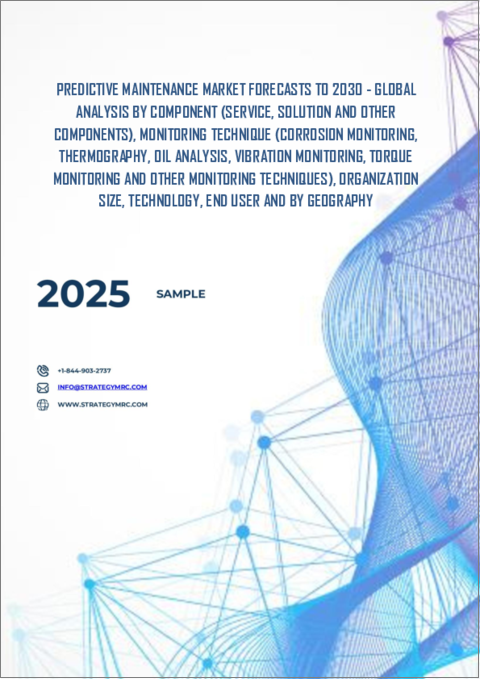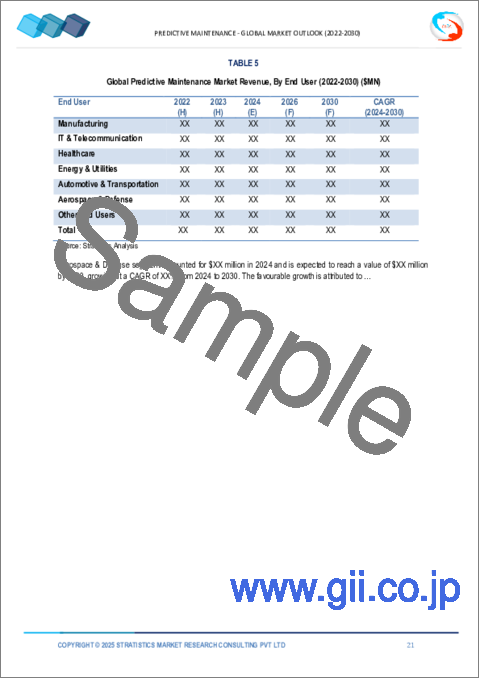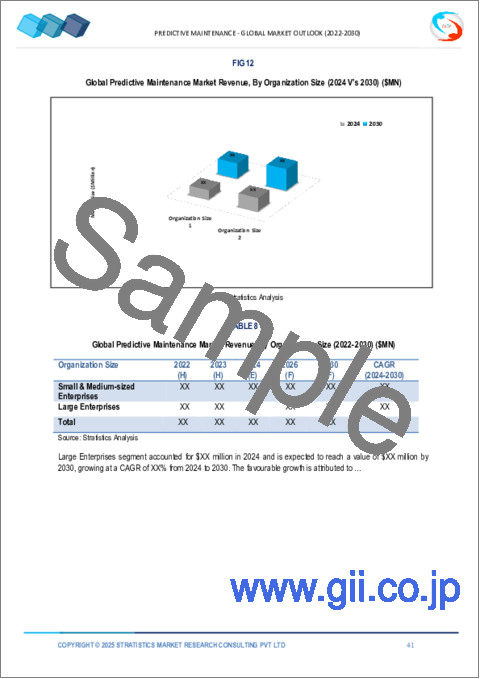|
|
市場調査レポート
商品コード
1489349
予知保全市場の世界市場予測(~2030年):コンポーネント、監視技術、組織規模、技術、エンドユーザー、地域別の分析Predictive Maintenance Market Forecasts to 2030 - Global Analysis By Component, Monitoring Technique, Organization Size, Technology, End User and By Geography |
||||||
カスタマイズ可能
|
|||||||
| 予知保全市場の世界市場予測(~2030年):コンポーネント、監視技術、組織規模、技術、エンドユーザー、地域別の分析 |
|
出版日: 2024年06月06日
発行: Stratistics Market Research Consulting
ページ情報: 英文 200+ Pages
納期: 2~3営業日
|
全表示
- 概要
- 図表
- 目次
世界の予知保全の市場規模は、2023年に103億4,000万米ドルを占め、予測期間中にCAGR31.7%で成長し、2030年には710億5,000万米ドルに達すると予想されています。 予知保全市場には、高度な分析、機械学習アルゴリズム、IoTセンサーの利用が含まれ、機器の故障を事前に予測することで、保全スケジュールを最適化し、ダウンタイムを削減します。
過去のデータとリアルタイムのセンサー情報を分析することで、予知保全ソリューションは潜在的な故障を示すパターンと異常を検出し、予防的な保全介入を可能にします。このアプローチにより、企業はコストのかかる計画外のダウンタイムを回避し、メンテナンスコストを最小限に抑え、資産の寿命を延ばすことができます。
世界銀行のデータによると、米国の2020年の製造業付加価値は2兆3,370億米ドルを大きく上回っています。カナダ政府の統計によると、製造業のGDPへの貢献は約1,740億カナダドル、製造業からの輸出は年間約3,540億カナダドルでした。
資産パフォーマンス管理への需要の高まり
APMは、データ分析、機械学習、IoTセンサーを統合し、産業資産の健全性と性能をリアルタイムで監視します。データを継続的に収集・分析することで、APMシステムは、潜在的な機器の故障や非効率性を示すパターンや異常を、発生前に特定することができます。このプロアクティブなアプローチにより、組織はメンテナンス・タスクをより効率的にスケジューリングし、ダウンタイムを最小限に抑え、全体的な運用コストを削減することができます。さらに、資産の寿命を最大化し、メンテナンス戦略を最適化することの重要性が業界でますます認識されるにつれ、APMソリューションの採用は増加の一途をたどっています。
導入コスト
予知保全技術は、機器の故障を事前に特定することで大幅なコスト削減の可能性を提供しますが、そのようなシステムを導入するために必要な初期投資は、多くの組織にとって法外なものになる可能性があります。このコストには、予知保全ソフトウェアとハードウェアの購入だけでなく、データ収集、統合、人材育成に関連する費用も含まれます。しかし、既存の機械にセンサーや接続機能を後付けすることは、さらにコストを上昇させる可能性があります。
センサー技術の進歩
センサー技術の進歩は、機器の健全性をより正確かつタイムリーに監視できるようにすることで、予知保全市場に革命をもたらしています。IoT接続、機械学習アルゴリズム、リアルタイムのデータ分析などの機能を備えたこれらのセンサーは、温度、振動、性能指標などのさまざまなパラメーターの継続的な監視を可能にします。このデータを収集・分析することで、予知保全システムは潜在的な機器の故障を事前に予測することができ、コストのかかるダウンタイムを防ぎ、運用効率を最大化することができます。さらに、これらのセンサーは、使用パターンと環境条件についての洞察を提供し、より正確なメンテナンス・スケジューリングとリソース割り当てを可能にします。
環境と運転の変動性
温度変動、湿度レベル、さまざまな要素への暴露などの環境要因は、時間とともに機器の性能にさまざまな影響を与えます。同様に、多様な使用パターン、作業負荷の変動、メンテナンスの慣行に起因する運転の変動性も、予知保全の取り組みをさらに複雑にします。このような動的な変動要因は、機器の故障やメンテナンスの必要性を正確に予測できる、堅牢な予測メンテナンスモデルの開発を困難にしています。また、業種によって運用環境が異なるため、さらに複雑さが増し、業種に合わせたソリューションが必要になります。
COVID-19の影響
企業は、ロックダウンやソーシャルディスタンスの中で、物理的な接触を最小限に抑え、業務の継続性を確保しようとするため、遠隔監視と予測分析技術の採用を加速させました。このような予知保全ソリューションに対する需要の急増は、製造、エネルギー、運輸などの重要産業において、資産パフォーマンスを最適化し、予期せぬダウンタイムを防止する必要性によってもたらされました。パンデミックによって引き起こされた景気減速は、企業がコスト効率と資産の最適化を優先するよう促し、オペレーションを合理化しリソースを最大限に活用するための予知保全ツールの採用をさらに促進しました。
腐食モニタリングセグメントは予測期間中最大になる見込み
腐食モニタリングセグメントは、予測期間中に最大となる見込みです。腐食は多くの産業で共通の問題であり、放置すると機器の劣化や構造的弱点、ひいてはコストのかかる故障につながります。腐食モニタリングシステムを予知保全戦略に組み込むことで、企業は腐食の初期兆候を検出し、さらなる損傷を防ぐためのタイムリーな介入が可能になります。これらのシステムは、センサー、プローブ、非破壊検査法などの様々な技術を利用して、腐食レベルを継続的に評価し、将来の劣化を予測します。
予測期間中にCAGRが最も高くなると予想されるのはエネルギー・公益事業セグメントです。
エネルギー・公益事業セグメントは、予測期間中に最も高いCAGRが見込まれます。発電所、送電網、公益施設には膨大なインフラと設備が広がっており、効率的なメンテナンスの実践が最も必要とされています。この分野における予知保全には、IoTセンサーを通じて機器の状態を継続的に監視し、膨大な量のデータを分析して異常を検出し、潜在的な故障を事前に予測することが含まれます。このプロアクティブ・アプローチは、メンテナンス・コストを削減するだけでなく、安全性と信頼性を向上させ、消費者への中断のないサービス提供を確保すると同時に、資源利用を最大化し、環境への影響を最小限に抑えます。
最大のシェアを占める地域
顧客チャネルの普及、資産メンテナンスと運用コストに対する懸念の高まり、人工知能(AI)、機械学習(ML)、音響モニタリング、モノのインターネット(IoT)などの最先端技術の採用増加により、北米が予測期間中に市場で最大のシェアを占める見通しです。さらに、同地域の市場は、予測メトリクスに対する認識の高まり、その重要性、早期技術導入の結果、さらに成長しています。
CAGRが最も高い地域
欧州は予測期間中に有益な成長を遂げると予測されます。エネルギー効率と排出削減に関する欧州連合の指令のような規制の実施は、企業が予知保全戦略を採用する動機付けとなっています。その結果、企業はこれらの規制を遵守すると同時に運用パフォーマンスを向上させるため、予知保全技術への投資を増やしています。さらに、予知保全ソリューションの採用に助成金、補助金、税制上の優遇措置を提供する政府のイニシアチブは、これらの技術をさまざまな分野の企業がより利用しやすくすることで、市場の成長をさらに刺激しています。
無料のカスタマイズ提供:
本レポートをご購読のお客様には、以下の無料カスタマイズオプションのいずれかをご利用いただけます:
- 企業プロファイル
- 追加市場企業の包括的プロファイリング(3社まで)
- 主要企業のSWOT分析(3社まで)
- 地域セグメンテーション
- 顧客の関心に応じた主要国の市場推計・予測・CAGR(注:フィージビリティチェックによる)
- 競合ベンチマーキング
- 製品ポートフォリオ、地理的プレゼンス、戦略的提携に基づく主要企業のベンチマーキング
目次
第1章 エグゼクティブサマリー
第2章 序文
- 概要
- ステークホルダー
- 調査範囲
- 調査手法
- データマイニング
- データ分析
- データ検証
- 調査アプローチ
- 調査情報源
- 1次調査情報源
- 2次調査情報源
- 前提条件
第3章 市場動向分析
- 促進要因
- 抑制要因
- 機会
- 脅威
- 技術分析
- エンドユーザー分析
- 新興市場
- COVID-19の影響
第4章 ポーターのファイブフォース分析
- 供給企業の交渉力
- 買い手の交渉力
- 代替品の脅威
- 新規参入業者の脅威
- 競争企業間の敵対関係
第5章 世界の予知保全市場:コンポーネント別
- サービス
- トレーニングとコンサルティング
- サポートとメンテナンス
- ソリューション
- スタンドアロン
- 統合型
- その他のコンポーネント
第6章 世界の予知保全市場:監視技術別
- 腐食監視
- サーモグラフィー
- オイル分析
- 振動監視
- トルク監視
- その他の監視技術
第7章 世界の予知保全市場:組織規模別
- 中小企業
- 大企業
第8章 世界の予知保全市場:技術別
- 人工知能
- 分析とデータ管理
- その他の技術
第9章 世界の予知保全市場:エンドユーザー別
- 製造
- IT・通信
- ヘルスケア
- エネルギー・公益事業
- 自動車・輸送
- 航空宇宙・防衛
- その他のエンドユーザー
第10章 世界の予知保全市場:地域別
- 北米
- 米国
- カナダ
- メキシコ
- 欧州
- ドイツ
- 英国
- イタリア
- フランス
- スペイン
- その他欧州
- アジア太平洋
- 日本
- 中国
- インド
- オーストラリア
- ニュージーランド
- 韓国
- その他アジア太平洋
- 南米
- アルゼンチン
- ブラジル
- チリ
- その他南米
- 中東・アフリカ
- サウジアラビア
- アラブ首長国連邦
- カタール
- 南アフリカ
- その他中東・アフリカ
第11章 主な発展
- 協定、パートナーシップ、コラボレーション、合弁事業
- 買収と合併
- 新製品発売
- 事業拡大
- その他の主要戦略
第12章 企業プロファイリング
- Siemens
- Schneider Electric SE
- Rockwell Automation
- Robert Bosch GmbH
- Microsoft
- IBM Corporation
- Hitachi, Ltd
- Honeywell International Inc
- General Electric
- Cisco Systems, Inc
- Accenture plc
List of Tables
- Table 1 Global Predictive Maintenance Market Outlook, By Region (2021-2030) ($MN)
- Table 2 Global Predictive Maintenance Market Outlook, By Component (2021-2030) ($MN)
- Table 3 Global Predictive Maintenance Market Outlook, By Service (2021-2030) ($MN)
- Table 4 Global Predictive Maintenance Market Outlook, By Training & Consulting (2021-2030) ($MN)
- Table 5 Global Predictive Maintenance Market Outlook, By Support & Maintenance (2021-2030) ($MN)
- Table 6 Global Predictive Maintenance Market Outlook, By Solution (2021-2030) ($MN)
- Table 7 Global Predictive Maintenance Market Outlook, By Standalone (2021-2030) ($MN)
- Table 8 Global Predictive Maintenance Market Outlook, By Integrated (2021-2030) ($MN)
- Table 9 Global Predictive Maintenance Market Outlook, By Other Components (2021-2030) ($MN)
- Table 10 Global Predictive Maintenance Market Outlook, By Monitoring Technique (2021-2030) ($MN)
- Table 11 Global Predictive Maintenance Market Outlook, By Corrosion Monitoring (2021-2030) ($MN)
- Table 12 Global Predictive Maintenance Market Outlook, By Thermography (2021-2030) ($MN)
- Table 13 Global Predictive Maintenance Market Outlook, By Oil Analysis (2021-2030) ($MN)
- Table 14 Global Predictive Maintenance Market Outlook, By Vibration Monitoring (2021-2030) ($MN)
- Table 15 Global Predictive Maintenance Market Outlook, By Torque Monitoring (2021-2030) ($MN)
- Table 16 Global Predictive Maintenance Market Outlook, By Other Monitoring Techniques (2021-2030) ($MN)
- Table 17 Global Predictive Maintenance Market Outlook, By Organization Size (2021-2030) ($MN)
- Table 18 Global Predictive Maintenance Market Outlook, By Small & Medium-sized Enterprises (2021-2030) ($MN)
- Table 19 Global Predictive Maintenance Market Outlook, By Large Enterprises (2021-2030) ($MN)
- Table 20 Global Predictive Maintenance Market Outlook, By Technology (2021-2030) ($MN)
- Table 21 Global Predictive Maintenance Market Outlook, By Artificial Intelligence (2021-2030) ($MN)
- Table 22 Global Predictive Maintenance Market Outlook, By Analytics & Data Management (2021-2030) ($MN)
- Table 23 Global Predictive Maintenance Market Outlook, By Other Technologies (2021-2030) ($MN)
- Table 24 Global Predictive Maintenance Market Outlook, By End User (2021-2030) ($MN)
- Table 25 Global Predictive Maintenance Market Outlook, By Manufacturing (2021-2030) ($MN)
- Table 26 Global Predictive Maintenance Market Outlook, By IT & Telecommunication (2021-2030) ($MN)
- Table 27 Global Predictive Maintenance Market Outlook, By Healthcare (2021-2030) ($MN)
- Table 28 Global Predictive Maintenance Market Outlook, By Energy & Utilities (2021-2030) ($MN)
- Table 29 Global Predictive Maintenance Market Outlook, By Automotive & Transportation (2021-2030) ($MN)
- Table 30 Global Predictive Maintenance Market Outlook, By Aerospace & Defense (2021-2030) ($MN)
- Table 31 Global Predictive Maintenance Market Outlook, By Other End Users (2021-2030) ($MN)
Note: Tables for North America, Europe, APAC, South America, and Middle East & Africa Regions are also represented in the same manner as above.
According to Stratistics MRC, the Global Predictive Maintenance Market is accounted for $10.34 billion in 2023 and is expected to reach $71.05 billion by 2030 growing at a CAGR of 31.7% during the forecast period. The Predictive Maintenance Market encompasses the use of advanced analytics, machine learning algorithms, and IoT sensors to predict equipment failures before they occur, thereby optimizing maintenance schedules and reducing downtime. By analyzing historical data and real-time sensor information, predictive maintenance solutions can detect patterns and anomalies indicative of potential breakdowns, enabling proactive maintenance interventions. This approach helps businesses avoid costly unplanned downtime, minimize maintenance costs, and extend the lifespan of their assets.
According to World Bank data, manufacturing value addition in 2020 in the US was well above USD 2,337 billion. According to Government of Canada statistics, the manufacturing sector's contribution to the GDP was nearly CAD 174 billion, and exports from the sector were approximated at CAD 354 billion per year.
Market Dynamics:
Driver:
Increasing demand for asset performance management
APM integrates data analytics, machine learning, and IoT sensors to monitor the health and performance of industrial assets in real-time. By continuously collecting and analyzing data, APM systems can identify patterns and anomalies that indicate potential equipment failures or inefficiencies before they occur. This proactive approach enables organizations to schedule maintenance tasks more efficiently, minimizing downtime and reducing overall operational costs. Furthermore, as industries increasingly recognize the importance of maximizing asset lifespan and optimizing maintenance strategies, the adoption of APM solutions continues to rise.
Restraint:
Cost of implementation
While predictive maintenance technology offers the potential for substantial cost savings by identifying equipment failures before they occur, the initial investment required to implement such systems can be prohibitive for many organizations. This cost encompasses not only the purchase of predictive maintenance software and hardware but also the expenses associated with data collection, integration, and personnel training. However, retrofitting existing machinery with sensors and connectivity features can further escalate costs.
Opportunity:
Advancements in sensor technologies
Advancements in sensor technologies are revolutionizing the predictive maintenance market by enabling more accurate and timely monitoring of equipment health. These sensors, equipped with capabilities like IoT connectivity, machine learning algorithms, and real-time data analysis, allow for continuous monitoring of various parameters such as temperature, vibration, and performance metrics. By collecting and analyzing this data, predictive maintenance systems can predict potential equipment failures before they occur, thus preventing costly downtime and maximizing operational efficiency. Additionally, these sensors provide insights into usage patterns and environmental conditions, allowing for more precise maintenance scheduling and resource allocation.
Threat:
Environmental and operational variability
Environmental factors such as temperature fluctuations, humidity levels, and exposure to various elements can impact equipment performance differently over time. Similarly, operational variability stemming from diverse usage patterns, workload fluctuations, and maintenance practices further complicates predictive maintenance efforts. These dynamic variables make it challenging to develop robust predictive maintenance models that can accurately anticipate equipment failures and maintenance needs. The diversity in operational environments across industries adds another layer of complexity, requiring tailored solutions for different sectors.
Covid-19 Impact:
It accelerated the adoption of remote monitoring and predictive analytics technologies as companies sought to minimize physical contact and ensure operational continuity amid lockdowns and social distancing measures. This surge in demand for predictive maintenance solutions was driven by the need to optimize asset performance and prevent unexpected downtime in critical industries such as manufacturing, energy, and transportation. The economic slowdown induced by the pandemic prompted businesses to prioritize cost efficiency and asset optimization, further driving the adoption of predictive maintenance tools to streamline operations and maximize resource utilization.
The Corrosion Monitoring segment is expected to be the largest during the forecast period
Corrosion Monitoring segment is expected to be the largest during the forecast period. Corrosion is a common issue in many industries, leading to equipment degradation, structural weakness, and ultimately, costly failures if left unchecked. By integrating corrosion monitoring systems into predictive maintenance strategies, businesses can detect early signs of corrosion, allowing for timely interventions to prevent further damage. These systems utilize various techniques such as sensors, probes, and non-destructive testing methods to continuously assess corrosion levels and predict future deterioration.
The Energy & Utilities segment is expected to have the highest CAGR during the forecast period
Energy & Utilities segment is expected to have the highest CAGR during the forecast period. With the vast infrastructure and equipment spread across power plants, grid networks, and utility facilities, the need for efficient maintenance practices is paramount. Predictive maintenance in this sector involves the continuous monitoring of equipment conditions through IoT sensors, analyzing vast amounts of data to detect anomalies and predict potential failures before they occur. This proactive approach not only reduces maintenance costs but also enhances safety and reliability, ensuring uninterrupted service delivery to consumers while maximizing resource utilization and minimizing environmental impact.
Region with largest share:
Due to the spread of customer channels, rising concerns over asset maintenance and operating costs, and the increasing adoption of cutting-edge technologies like artificial intelligence (AI), machine learning (ML), acoustic monitoring, and the Internet of Things (IoT), North America commanded the largest share of the market during the extrapolated period. Furthermore, the market in the region has grown even more as a result of growing awareness of predictive metrics, their significance, and early technological adoption.
Region with highest CAGR:
Europe region is projected to witness profitable growth over the forecast period. The implementation of regulations such as the European Union's directives on energy efficiency and emissions reduction is incentivizing companies to adopt predictive maintenance strategies. Consequently, companies are increasingly investing in predictive maintenance technologies to comply with these regulations while simultaneously improving their operational performance. Moreover, government initiatives offering grants, subsidies, or tax incentives for adopting predictive maintenance solutions further stimulate market growth by making these technologies more accessible to businesses across different sectors.
Key players in the market
Some of the key players in Predictive Maintenance market include Siemens, Schneider Electric SE, Rockwell Automation, Robert Bosch GmbH, Microsoft, IBM Corporation, Hitachi, Ltd, Honeywell International Inc, General Electric, Cisco Systems, Inc and Accenture plc.
Key Developments:
In July 2022, two companies in Houston announced they would develop a new predictive maintenance software. Shape Corporation, along with Radix Engineering and Software, collaborated to develop a tool that would enable companies that operate floating production units to implement their system to positively impact their cash flow and environment, and health impact.
In July 2022, Keolis and Stratio announced a partnership that would provide predictive maintenance solutions to Keolis' fleet. Keolis provides solutions to public transit systems, and Stratio develops computerized maintenance management systems; The Stratio Platform will enable real-time data to be made available to Keolis' engineers to ensure minimal downtime.
In July 2022, Valmet announced a new application that would enable better tracking of machinery. The application is part of Valmet Industrial Internet portfolio which offers predictive maintenance and root cause analysis solutions for various machines in the paper and pulp industry.
In March 2022, C3 AI announced that it had reached a phenomenal number of more than 10,000 machines of Shell Corporation under their predictive maintenance program. The program uses more than 3 million sensors and 11,000 ML models.
Components Covered:
- Service
- Solution
- Other Components
Monitoring Techniques Covered:
- Corrosion Monitoring
- Thermography
- Oil Analysis
- Vibration Monitoring
- Torque Monitoring
- Other Monitoring Techniques
Organization Size Covered:
- Small & Medium-sized Enterprises
- Large Enterprises
Technologies Covered:
- Artificial Intelligence
- Analytics & Data Management
- Other Technologies
End Users Covered:
- Manufacturing
- IT & Telecommunication
- Healthcare
- Energy & Utilities
- Automotive & Transportation
- Aerospace & Defense
- Other End Users
Regions Covered:
- North America
- US
- Canada
- Mexico
- Europe
- Germany
- UK
- Italy
- France
- Spain
- Rest of Europe
- Asia Pacific
- Japan
- China
- India
- Australia
- New Zealand
- South Korea
- Rest of Asia Pacific
- South America
- Argentina
- Brazil
- Chile
- Rest of South America
- Middle East & Africa
- Saudi Arabia
- UAE
- Qatar
- South Africa
- Rest of Middle East & Africa
What our report offers:
- Market share assessments for the regional and country-level segments
- Strategic recommendations for the new entrants
- Covers Market data for the years 2021, 2022, 2023, 2026, and 2030
- Market Trends (Drivers, Constraints, Opportunities, Threats, Challenges, Investment Opportunities, and recommendations)
- Strategic recommendations in key business segments based on the market estimations
- Competitive landscaping mapping the key common trends
- Company profiling with detailed strategies, financials, and recent developments
- Supply chain trends mapping the latest technological advancements
Free Customization Offerings:
All the customers of this report will be entitled to receive one of the following free customization options:
- Company Profiling
- Comprehensive profiling of additional market players (up to 3)
- SWOT Analysis of key players (up to 3)
- Regional Segmentation
- Market estimations, Forecasts and CAGR of any prominent country as per the client's interest (Note: Depends on feasibility check)
- Competitive Benchmarking
- Benchmarking of key players based on product portfolio, geographical presence, and strategic alliances
Table of Contents
1 Executive Summary
2 Preface
- 2.1 Abstract
- 2.2 Stake Holders
- 2.3 Research Scope
- 2.4 Research Methodology
- 2.4.1 Data Mining
- 2.4.2 Data Analysis
- 2.4.3 Data Validation
- 2.4.4 Research Approach
- 2.5 Research Sources
- 2.5.1 Primary Research Sources
- 2.5.2 Secondary Research Sources
- 2.5.3 Assumptions
3 Market Trend Analysis
- 3.1 Introduction
- 3.2 Drivers
- 3.3 Restraints
- 3.4 Opportunities
- 3.5 Threats
- 3.6 Technology Analysis
- 3.7 End User Analysis
- 3.8 Emerging Markets
- 3.9 Impact of Covid-19
4 Porters Five Force Analysis
- 4.1 Bargaining power of suppliers
- 4.2 Bargaining power of buyers
- 4.3 Threat of substitutes
- 4.4 Threat of new entrants
- 4.5 Competitive rivalry
5 Global Predictive Maintenance Market, By Component
- 5.1 Introduction
- 5.2 Service
- 5.2.1 Training & Consulting
- 5.2.2 Support & Maintenance
- 5.3 Solution
- 5.3.1 Standalone
- 5.3.2 Integrated
- 5.4 Other Components
6 Global Predictive Maintenance Market, By Monitoring Technique
- 6.1 Introduction
- 6.2 Corrosion Monitoring
- 6.3 Thermography
- 6.4 Oil Analysis
- 6.5 Vibration Monitoring
- 6.6 Torque Monitoring
- 6.7 Other Monitoring Techniques
7 Global Predictive Maintenance Market, By Organization Size
- 7.1 Introduction
- 7.2 Small & Medium-sized Enterprises
- 7.3 Large Enterprises
8 Global Predictive Maintenance Market, By Technology
- 8.1 Introduction
- 8.2 Artificial Intelligence
- 8.3 Analytics & Data Management
- 8.4 Other Technologies
9 Global Predictive Maintenance Market, By End User
- 9.1 Introduction
- 9.2 Manufacturing
- 9.3 IT & Telecommunication
- 9.4 Healthcare
- 9.5 Energy & Utilities
- 9.6 Automotive & Transportation
- 9.7 Aerospace & Defense
- 9.8 Other End Users
10 Global Predictive Maintenance Market, By Geography
- 10.1 Introduction
- 10.2 North America
- 10.2.1 US
- 10.2.2 Canada
- 10.2.3 Mexico
- 10.3 Europe
- 10.3.1 Germany
- 10.3.2 UK
- 10.3.3 Italy
- 10.3.4 France
- 10.3.5 Spain
- 10.3.6 Rest of Europe
- 10.4 Asia Pacific
- 10.4.1 Japan
- 10.4.2 China
- 10.4.3 India
- 10.4.4 Australia
- 10.4.5 New Zealand
- 10.4.6 South Korea
- 10.4.7 Rest of Asia Pacific
- 10.5 South America
- 10.5.1 Argentina
- 10.5.2 Brazil
- 10.5.3 Chile
- 10.5.4 Rest of South America
- 10.6 Middle East & Africa
- 10.6.1 Saudi Arabia
- 10.6.2 UAE
- 10.6.3 Qatar
- 10.6.4 South Africa
- 10.6.5 Rest of Middle East & Africa
11 Key Developments
- 11.1 Agreements, Partnerships, Collaborations and Joint Ventures
- 11.2 Acquisitions & Mergers
- 11.3 New Product Launch
- 11.4 Expansions
- 11.5 Other Key Strategies
12 Company Profiling
- 12.1 Siemens
- 12.2 Schneider Electric SE
- 12.3 Rockwell Automation
- 12.4 Robert Bosch GmbH
- 12.5 Microsoft
- 12.6 IBM Corporation
- 12.7 Hitachi, Ltd
- 12.8 Honeywell International Inc
- 12.9 General Electric
- 12.10 Cisco Systems, Inc
- 12.11 Accenture plc





